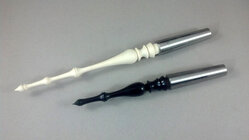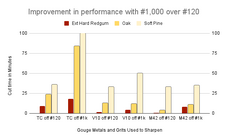Hi all - I have two CBN wheels on my grinder - an 80 grit for profiling and 180 for sharpening. I don’t use the 80 grit all that often so I’m considering swapping it out for another grit. Is there any reason to go above 180 grit? What does that do for you? I’ve never been able to find an answer, though I know people have vastly different opinions about this sort of thing. Happy thanksgiving!
-
November 2025 Turning Challenge: Wall Hanging! (click here for details) -
Sign up for the 2025 AAW Forum Holiday Swap by Monday, November 24th (click here for details) -
Congratulations to Konstantin Gusev for "The Nutcracker" being selected as Turning of the Week for November 17, 2025 (click here for details) -
Welcome new registering member. Your username must be your real First and Last name (for example: John Doe). "Screen names" and "handles" are not allowed and your registration will be deleted if you don't use your real name. Also, do not use all caps nor all lower case.
You are using an out of date browser. It may not display this or other websites correctly.
You should upgrade or use an alternative browser.
You should upgrade or use an alternative browser.
CBN wheel grits
- Thread starter Matt Friedman
- Start date
I do use my 80 grit wheel (for shaping), but if you don't, and you want to replace yours, I would say the replacement depends on your sharpening skills and whether or not you use a jig. If you do your sharpening with a jig like the Wolverine jig, and you know the process well, you will be closely following the existing grind profile, such that one or two passes on a 600 grit wheel will get you a great edge with minimal removal of steel. On the other hand, if your sharpening routine is more freehand or less familiar to you, such that it requires the removal of more metal, a 600 grit wheel might not work for you.
I have a wolverine system and feel pretty comfortable with my process. I use my 80 grit wheel for shaping, but it's not that frequent. It's infrequent enough that changing out the wheels when I need to do shaping wouldn't be that big of a hassle. Would I get a markedly better cut on a piece with a 600 grit wheel vs 180? Or is it more about the amount of steel that's removed?I do use my 80 grit wheel (for shaping), but if you don't, and you want to replace yours, I would say the replacement depends on your sharpening skills and whether or not you use a jig. If you do your sharpening with a jig like the Wolverine jig, and you know the process well, you will be closely following the existing grind profile, such that one or two passes on a 600 grit wheel will get you a great edge with minimal removal of steel. On the other hand, if your sharpening routine is more freehand or less familiar to you, such that it requires the removal of more metal, a 600 grit wheel might not work for you.
I believe that the edge from a 600 grit wheel is better, but many turners consider the edge from a 180 grit wheel to be as good as could be needed.
john lucas
AAW Forum Expert
Finer grits will not improve the finish off the tool. Finer grits remove less steel so your tool may last longer. Finer grits require a more accurate grind or you may not remove enough steel to actually get the tool sharp.
CBN wheels: what kinds of things do/will you turn?
Many people have experience and certainly have opinions based on that experience.
Sometimes the opinion depends on the way a person works and maybe more importantly, on what they turn.
I've had a bunch of different CBN grits. What I use now is:
60 grit on bench grinder (for shaping and making new tools)
600 grit on bench grinder (for sharpening skews, bowl gouges, scrapers, NRS, parting tools)
1200 grit on a Tormek (for sharpening spindle gouges)
I mostly turn dry wood, often hard and fine grained woods, lots of exotics, plenty of spindles.
For my use the finer grit the better the finish off the tool and the less sanding required. The holly finial in this picture is off the tool with no sanding, spindle gouge sharpened on 1200 grit CBN.
The ebony finial had light sanding with fine grit paper.

If turning bowls from green wood the grit of the sharpening grit wouldn't mater much but coarser grit wastes more steel.
If turning bowls/platters from dry wood the finer sharpening wheel can make a difference UNLESS you like to sand with disks on a drill, then use any grit CBN. I don't power sand. I turn, use hand scrapers to smooth, then sand by hand.
If you know other turners in your area or club, you might try sharpening on various CBN wheels and decide what works best for you.
JKJ
Many people have experience and certainly have opinions based on that experience.
Sometimes the opinion depends on the way a person works and maybe more importantly, on what they turn.
I've had a bunch of different CBN grits. What I use now is:
60 grit on bench grinder (for shaping and making new tools)
600 grit on bench grinder (for sharpening skews, bowl gouges, scrapers, NRS, parting tools)
1200 grit on a Tormek (for sharpening spindle gouges)
I mostly turn dry wood, often hard and fine grained woods, lots of exotics, plenty of spindles.
For my use the finer grit the better the finish off the tool and the less sanding required. The holly finial in this picture is off the tool with no sanding, spindle gouge sharpened on 1200 grit CBN.
The ebony finial had light sanding with fine grit paper.

If turning bowls from green wood the grit of the sharpening grit wouldn't mater much but coarser grit wastes more steel.
If turning bowls/platters from dry wood the finer sharpening wheel can make a difference UNLESS you like to sand with disks on a drill, then use any grit CBN. I don't power sand. I turn, use hand scrapers to smooth, then sand by hand.
If you know other turners in your area or club, you might try sharpening on various CBN wheels and decide what works best for you.
JKJ
I use a 600 to put a burr on scrapers. A 180 burr is too rough.Hi all - I have two CBN wheels on my grinder - an 80 grit for profiling and 180 for sharpening. I don’t use the 80 grit all that often so I’m considering swapping it out for another grit. Is there any reason to go above 180 grit? What does that do for you? I’ve never been able to find an answer, though I know people have vastly different opinions about this sort of thing. Happy thanksgiving!
This is all really great advice. Thanks everyone!
Curious by what you mean? 180 burr takes off too much material or doesn’t leave as fine a surface with scrapers?I use a 600 to put a burr on scrapers. A 180 burr is too rough.
I find a 600# wheel plenty fast for frequent touchups without removing too much steel, and I am running a 6" wheel at 1120 rpm. I have the 600 wheel on one side with a varigrind jig and a 180 on the other with a roborest platform for freehand grinding, mostly scrapers. An 80# cbn wheel for reshaping would be handy occasionally, but I use an aluminum oxide wheel on a high speed grinder with a mister for that.
Make what you will of these result that I got from testing after grinding on different abrasive grit grades... your experience may be different.

I re-sharpen TC on #1k, V10 and M42 on #340 as V10 didn't benefit much from a finer grit , but I probably should re-sharpen M42 on at least #600 or #800 if not #1K.

I re-sharpen TC on #1k, V10 and M42 on #340 as V10 didn't benefit much from a finer grit , but I probably should re-sharpen M42 on at least #600 or #800 if not #1K.
For a couple decades 60, 100, and 120 grit aluminum oxide wheels treated me fine, just fine. Peachy. Tons of ribbons of wood flying all over the place. A few years ago I bought a 180g CBN. Tons of ribbons of wood flying all over the place. I recently installed a 600g CBN. Tons of ribbons of wood flying all over the place.
The difference across those grits is the quality of the edge under strong magnification. Spinning wood will succumb to a fresh 60g edge, just like your fingertip will. The practical difference between those resulting edges from those different grits is how cleanly they shear the wood fibers, or how cleanly they slice your fingertip. (A ragged edge cut always hurts more than a clean edge cut.)
I can sharpen a carving knife on 60g and get back to work, but the better result will come when I sharpen that knife up over 1000g. Or 5000g. Or 8000g.
That 600g CBN puts a wicked edge on my turning tools. 180 and 600 CBN are now my 60 and 120 aluminum oxide wheels. Well, 600 is now the regularly used wheel to sharpen, the 180 is just spinning over on the other end of the machine, waiting for a reason to grind something.
The difference across those grits is the quality of the edge under strong magnification. Spinning wood will succumb to a fresh 60g edge, just like your fingertip will. The practical difference between those resulting edges from those different grits is how cleanly they shear the wood fibers, or how cleanly they slice your fingertip. (A ragged edge cut always hurts more than a clean edge cut.)
I can sharpen a carving knife on 60g and get back to work, but the better result will come when I sharpen that knife up over 1000g. Or 5000g. Or 8000g.
That 600g CBN puts a wicked edge on my turning tools. 180 and 600 CBN are now my 60 and 120 aluminum oxide wheels. Well, 600 is now the regularly used wheel to sharpen, the 180 is just spinning over on the other end of the machine, waiting for a reason to grind something.
Last edited:
